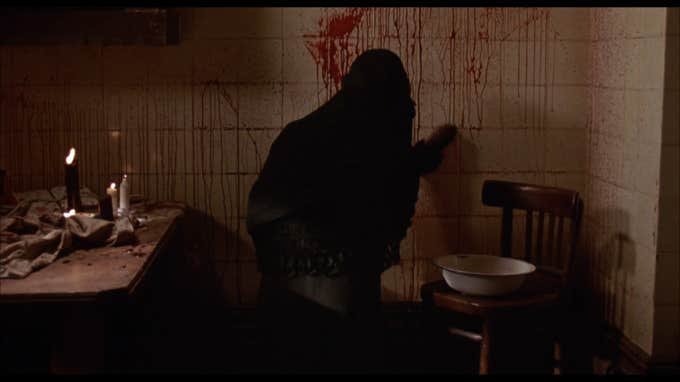
The unnamed character whom fans call “The Woman Black” is seen cleaning up after human sacrifices, but clues point to her being the master and not the servant.
Understanding “Angel Heart” Part 1
The Devil is in the Details
By
Owen Hammer
This is the first of two essays in which I will explain the mysteries behind Alan Parker’s supernatural noir detective film Angel Heart (1987). In this essay, I will explain the meaning behind some of the cryptic events in the movie and in the second essay I will explain the mechanics of time in the movie. The essay is split into two parts because the second part is much more esoteric and requires an attention to detail that borders on the obsessive, but this first part will be a more digestible overview of the film, looking at themes and perhaps a thesis.
Angel Heart is one of those movies with such a great twist ending that explains so much of the mystery that no one thinks of it as a cryptic film. However, when you look at the many mysteries that remain after the big reveal, you realize that there’s a second big reveal mercilessly left unavailable to the audience. When you put the pieces together, the tragic ending seems optimistic in comparison.
In the movie, hardboiled 1950’s New York City private detective Harold Angel (Mickey Rourke) is hired by the conspicuously sinister LOUIS CYPHRE (Robert DeNiro) to find the missing crooner JOHNNY FAVORITE. “Lou Cyphre” or “Lucifer” is obviously the Devil and Johnny made a traditional Faustian bargain with him and skipped out on the bill. Already the story is intriguing. How does one hide from the Devil? Whenever the Faust story is told, the possibility of pulling the old switcheroo on the Prince of Darkness is off the table.
In the end, Harold Angel is Johnny Favorite, and Harry finds himself damned while the credits play. Well, Harry is in an old-fashioned, rickety cage elevator descending, and it’s assumed that this represents the protagonist going to Hell.
But that’s the thing about Angel Heart — there is so much ambiguity and so many uneasy assumptions. We never really learn who the Lady in Black is. Yes, we learn that it’s Robert DeNiro, presumably bi-locating as two distinct demonic entities, but that doesn’t even come close to a satisfying explanation. What’s the deal with all the fans? Why is Harry afraid of chickens? Who’s the dead woman at the beginning? Who’s the “parishioner’s husband” who commits suicide? Did he commit suicide? Is Epiphany’s child now the Devil? And what’s with the nose shield?
CHEATING THE DEVIL
First, let’s look at the process of Johnny Favorite becoming this dual-identity being—a Jekyll and Hyde type. We are not yet diving into the subtext, as this is all clearly explained in the text of the film, but I doubt that even the most attentive viewer could have digested this convoluted backstory on the first viewing. Also, a lot of viewers are thrown by the fact that two events happen on two different New Year’s Eves, and if you think that these two events happen on the same day, you will be hopelessly lost.
Here’s the timeline.
In the nineteen thirties, John Leibling makes a deal with the Devil. He will become Johnny Favorite a famous crooner á la Frank Sinatra. Presumably, in exchange for this wealth and success, he will go to Hell when he dies. It’s actually a deal so terrible that the “Faustian Bargain” plot device is brought into question, although, maybe that’s on purpose.
Johnny Favorite befriends fellow occultists, the wealthy Ethan Krusemark (Stocker Fontelieu), his daughter Margaret Krusemark (Charlotte Rampling) and Jazz musician TootS Sweet (Brownie McGhee). Ethan Krusemark mentions that he saw Johnny conjure a “lucifuge” once and this may have been the initial meeting between Johnny and the Devil.
Johnny, an honor student in black magic, finds a loophole in the Faustian Bargain. He and the other three plan to steal the soul of a random stranger who roughly matches Johnny in age and size. Johnny will then destroy the poor sap and consume the soul. With two souls in his body, Johnny will be undetectable by the Devil.
This leaves the viewer to make a lot of assumptions — that the second soul is not “dominant” in the dual-soul body and that the Devil has some kind of blindspot that makes such a being invisible.
The plan is executed on December 31st, 1942 at the New Year’s Eve celebration in Times Square. The scenes of celebration have “1943” signs plastered everywhere since it’s the coming year that is celebrated. December 31st, 1943 will also become a significant date, and this is why so many viewers are confused. While there is a lot of purposeful ambiguity in Angel Heart, I think that this is unintentional.
Johnny, Toots and Margaret find HAROLD ANGEL, a soldier in World War II, having a blast in Times Square. The sinister trio take Harry to a hotel room, murder him in a demonic rite, and Johnny eats his beating heart, thus consuming his soul. The hotel has an eerie spiral staircase, and this is what allows the flashbacks to be parsed and understood. When someone is going up the staircase, this is before the human sacrifice, when we see them going down the staircase, that is after the sacrifice. Note that we never see Harry leaving because he does not leave.
Additionally a WOMAN IN BLACK is present. This is a very important character and the lack of explanation for her presence is conspicuous in its absence. She cleans up the blood with a bowl of water and a brush. However, she is the first to show up, meaning that she has foreknowledge of the murder, and it appears that the others can’t see her. Surely you don’t plan a human sacrifice by hiring a cleaning service in advance (I have never planned a human sacrifice, so this is speculation). The character is clearly supernatural, or she’s symbolic, or both.
But let’s get back to Johnny, who is not safe from damnation. While performing abroad in 1943, he is badly injured, his face and his brain both damaged. Reconstructive surgery leaves him with a new face and brain damage leaves him an imbecile. Let’s remember that this reconstructed face is neither the face of Johnny Favorite nor the face of Harold Angel. It is a third face — the face of Mickey Rourke. Because he is bandaged when Ethan and Margaret visit him, they do not know what the new face looks like. This is a necessary contrivance so that when they meet him in the future, they do not recognize him.
Well, Johnny has a big problem now. His plan to cheat the Devil has failed. He is “detectable” now, either supernaturally, or the Devil can follow the paper trail left by his handlers since he requires full-time care.
This is another source of confusion. You would think that a plan to hide from the Devil would involve changing your appearance, but it was coincidental that Johnny’s appearance changed and that this ended up being a disadvantage to him. Johnny planned to become “Harold Angel” and presumably no one would question that this Harold Angel guy looks just like Johnny Favorite, the famous singer.
Ethan decides that there is only one way to protect Johnny and that is to drop him off in Times Square on New Year’s Eve, 1943. The Harold Angel personality will re-assert itself, and it will seem as though nothing happened. There is no explanation as to what happens when “Harry” realizes that it is January 1st, 1944 and not January 1st, 1943. Nonetheless, the body of Johnny and the remnants of his soul, and the consciousness of Harold Angel are now Harold Angel (Mickey Rourke), who is unaware that he jumped into a different body when he lost a year of time.
Harry claims that he suffered great mental and physical injury in the war, and apparently he dismisses all of the strangeness of that. As implausible as that is, it works, as a protagonist in a fugue state has a mysterious past, and that’s a boon in such a story.
So, Harry is a kind of Jekyll and Hyde, wherein “Johnny” can take over and commit heinous acts while Harry is unaware. But here’s where my theorizing diverges from the conclusions that the text of the film guides us towards. Is Harry a Jekyll and Hyde? Does he turn into Johnny? I think that the answer is “no.”
THE DEVIL’S ADVOCATE
First let’s consider the most superficial interpretation of the events. It goes something like this:
MURDER #1: On a night in 1955, likely Sunday, January 2nd, Harry visits Dr. Fowler (Michael Higgins), locks him up in his bedroom and goes to get food. A fan begins to turn and then turns backwards. Off-screen (and Johnny is always off-screen), Harry turns into Johnny, goes back to the house, shoots Fowler with Fowler’s gun, removes his ring, and returns to being Harry. While this happens, Harry has a vision of a creepy church with an elevator.
After eating, Harry returns to Fowler’s house and is surprised to find that Fowler is dead. Harry assumes that Johnny—a separate and distinct entity—killed Fowler in order to stop Fowler from giving Harry more information. Johnny’s goal is to stay hidden, and he is willing to kill to achieve it.
MURDER #2: On a Wednesday afternoon, Harry visits Margaret Krusemark. He receives an astrological forecast, inspects a ceremonial knife (the one used to kill the real Harold Angel), and is rushed out, perhaps because Margaret suspects that’s he’s Johnny.
Harry becomes Johnny, returns and murders Margaret, slicing open her chest with the ritual knife. Johnny cuts out her heart and leaves it in pristine condition on a desk.
MURDER #3: Late at night, Harry visits Toots Sweet and gets more information. He is bleeding because, in a struggle, Toots managed to cut Harry’s hand with a straight razor. Harry gets his information and leaves, but, off-screen, Harry transformed into Johnny and murdered Toots in a graphic and horrible manner. Harry drops the straight razor on the way out of Toots’s apartment—a sign that he abandoned violence or a sign that the violent act has been completed.
Whatever happens next, we don’t see it. We see Harry have a vision of the Woman in Black in front of an electric chair. Presumably, Harry has these visions whenever Johnny takes over.
In the dream, the Woman in Black has the bloody razor. This is the third time Harry encounters the spirit, and for the second time, he tries to pull off her shroud and identify her. He is awoken by the police before that happens. Note that Harry’s failed attempts to pull off the shroud is a direction to us to consider the woman’s identity to be a great mystery.
On a Wednesday morning, the police inform Harry of Toots’s murder and he worries that Margaret may have been murdered. He gets to Margaret’s apartment at 2:00 PM and finds her body. Harry removes all evidence of his connection to Margaret by ripping out the page on her schedule listing him as a client. It is not obvious in the movie, but it is clear in the book, that the heart is on top of the astrological chart that Margaret made for Harry which may incriminate him. He has to get the paper out without disturbing the heart.
MURDER #4: Even though everyone he interrogates dies, Harry throws caution to the wind and confronts Ethan Krusemark. Ethan reveals much of the backstory, including Johnny’s absorption of “a boy” and the revelation of this information must have really pissed off Johnny because he takes over Harry’s body and tosses Ethan into a giant boiling pot of gumbo—a very original murder weapon and possibly meant to invoke ritual cannibalism.
MURDER #5: Johnny presumably killed Epiphany Proudfoot (Lisa Bonet), but it is difficult to put the murder on the timeline. In fact, if Harry transformed into Johnny and Johnny killed Epiphany, it would have had to happen before the murder of Ethan Krusemark as there is simply no time for Johnny to run back to the hotel and return to being Harry.
Another thing that is different about the murder of Epiphany: we know that Lou Cyphre is at least partially involved with it. Cyphre takes Harry’s dog tags and gun and plants them at the crime scene. Did Cyphre merely plant evidence incriminating Harry? If not, this leaves open the possibility that Cyphre committed the murder and that leaves open the possibility that Cyphre committed all the murders.
CAVEAT DIRECTOR
I have to drop a big qualification before I continue. I watched the film with the director’s commentary and many of the mysterious things I set out to explain were dismissed by Parker as random and pointless additions to the film with no over-arching theme in mind.
In other words, I cannot say that I am ferreting out the filmmakers’ intentions in this essay. However, the pieces of the puzzle fit together so well, and I know that many of the things he said in the commentary track are untrue. He claims that a lot of the weird additions were invented on the spot while filming, but these things are described in the script, including the early drafts.
Parker says that the decision to have Harry wear a nose protector was a last-minute decision because someone found a box of them[1], just as IZZY (George Buck) claims to have found the box in-universe. However, the nose guards were always in the script, and you can’t ad-lib a detail like that[2]. Besides, the nose protector is in the script for a reason. Harry wears it because the materials used to reconstruct his face can deform in the sun. This means that Harry’s face can actually transform into something different, however, since Johnny is supposed to be a different soul in another body, and not vice versa, this is needlessly confusing and I would conjecture that this is why the scene was never filmed.
Also, Epiphany’s son is afraid of the nose guard and Parker says that the unnamed child actor was scared of the nose guard in real life and that’s why they kept it in[3]. This is also not true. The scene as it exists in the theatrical cut is also in the script[4]. Since the glasses and nose guard cover up the portion of Harry’s face that was surgically altered, that would mean that he would look like Johnny Favorite with them on. I don’t know why the boy would know what Johnny Favorite would look like—maybe he can just broadly identify evil. The scene is a non-sequitur without the prior scenes, but it was intended to be a clue that Harry was Johnny.
Parker claims that Harry’s hatred of chickens was added to the script because he himself, Parker, hates chickens[5]. While this could be true, it is a truly bizarre choice.
We can easily see that chickens represented victims in general or the damned specifically. Chickens are brutally sacrificed by Epiphany’s congregation. The White Christians, the “mainstream” counterpart, happily engage in cockfighting[6]. Lou Cyphre references the symbology of the egg representing the soul, as he cruelly bites into eggs, presumably literally eating souls, which is an established phenomenon in the “Angel Heart” cosmology. Chickens are victims. Harry fears chickens because he fears being a victim. People tend to hate what they fear becoming and also there is a metatextual explanation. He’s the archetypical main character, the tough PI who constantly outwits or outfights his enemies, not a nameless nobody who gets sacrificed for plot convenience. By going to Hell, he is the ultimate victim in the end, and his aversion of the birds was as silly as it seemed. His fear of chickens is a statement of “it can’t happen to me,” and it does.
When The Woman in Black is revealed to be Robert DeNiro, Parker claims that it is Robert DeNiro “in drag[7].” What? Parker is obviously not interested in answering any of the big questions.
Alan Parker died in 2020 but it seems that he retroactively rebutted this commentary. Judge for yourself.
THE DEVIL MADE HIMSELF DO IT
So, let’s take a close look at Johnny Favorite. When do we see Johnny commit the murders? Never, really, except for five very quick shots wherein Harry, presumably with Johnny “in charge,” is committing the murders. But are we seeing what happened or are we seeing Harry’s memories? Since Angel Heart is mostly a protagonist-exclusive narrative, wherein we only see what Harry sees, it seems likely that these images are in the mind of Harry, but does that make them memories? Reality is so ephemeral that it seems just as likely that Harry thinks he remembers these events. Therefore, it is reasonable that Cyphre or his confederates committed the murders.
This should come as no surprise, as Cyphre has killed a lot of people. The unnamed woman at the beginning of the film was murdered by Cyphre, possibly for no reason. Winesap was murdered by Cyphre and we saw it. Granted, we don’t know how we saw it, the image simply flashes, but Cyphre confesses to the murder.
And what about the off-screen “Parishioner’s Husband” who committed suicide according to the official story? I’m going to go ahead and assume that he was killed by Cyphre and that we are meant to presume that he was killed by Cyphre. A random suicide just happened to take place in a satanic murder spree? That seems fishy.
There’s no way to know who the Parishioner’s Husband was or why he was killed (or if there was any motive, no matter how sinister or rational). However, this is a clue in and of itself. This loose plot thread is very conspicuous in its lack of information. In fact, you could argue that the character of the Parishioner’s Husband disappeared from the movie. All the characters forgot about him.
Think about your own experience watching the movie. You forgot about him too, didn’t you? If you’re like me, the second time you watched the movie and you saw the bloody mess left by the “suicide” you said, “Oh yeah. That guy. What was that about, anyway?”
Notice that the character vanished from your memory, just as evidence of his murder was removed by a supernatural character in the movie. Now we can start to understand the meaning of the Woman in Black.
PERSONS UNKNOWN
The Woman in Black erases a “Dexter”-level amount of blood with a bowl of cold water and a brush. I have to think that this act is entirely symbolic, for a lot of reasons. We know that she didn’t strip the paint, re-prime the walls, match the shade and re-paint, all while getting the necessary special permits to clean up a medically hazardous crime scene. But the blood is completely gone. The defects in the paint and wall under the blood are even restored.
This supernatural bit of housework wouldn’t be significant if there was a quick shot of the cleaned-up office. However, Harry returns to the office to investigate Cyphre and is just as surprised as we are to see that the blood is gone. He lingers in that office for a long time. Remember, this is not relevant to Harry’s role as an investigator for Cyphre. He is investigating Cyphre as most people would. Well, most people wouldn’t accept a job from the Devil, but at least Harry is doing some due diligence.
Given that the Parishioner’s Husband is conspicuously forgotten, I would ask, did the Woman in Black clean up the blood, or did she erase the event? I don’t necessarily mean that she can alter reality, although that’s not off the table, but if her point is to be a symbolic figure, then she could symbolize the act of purposely forgetting something. Perhaps Cyphre killed the poor guy, and history was being changed as the Woman in Black started cleaning. She’s sort of a satanic Ray Donovan. Did Winesap say that it was a suicide because he was covering up for Cyphre, or did he honestly but falsely remember it was a suicide?
If this seems far out, let’s remember that altering the past, or records of the past is a prominent theme. Fowler changed the records of Johnny’s transfer. Harry alters the tape recorder to keep secrets hidden from Cyphre. To cover his tracks after the murder of Margaret Krusemark, Harry removes the page from the calendar that records their meeting, almost as if he makes the day disappear.
When asked about Johnny, Toots Sweet feigns having little memory of him. He claims that he mostly remembers that Johnny made a record out of one of his songs. The only record (general definition) of Johnny is a record (specific definition).
Speaking of records, in the second-to-last scene, Harry and Cyphre are walking all over vinyl LPs that got dumped onto the floor somehow. They are literally destroying records.
And what about the “celebrity” Johnny Favorite? Why is it that most people don’t remember him? If it wasn't for Izzy’s Wife (Judith Drake), no character would acknowledge that Johnny was famous and successful. When Harry’s lover and research assistant Connie (Elizabeth Whitcraft) has the resources of the New York Times at her disposal to look up Johnny, she uncovers little. “I didn’t know he was famous,” she says, which is a paradox. If he’s famous, you know him, if he’s not famous, there’s nothing to know. Did Johnny Liebling sell his soul to the Devil to be a d-list singer?
It feels like the Devil “erased” Johnny’s fame and fortune. And why not? Assuming that this is within his power, if Johnny cheats him, he won’t hesitate to revoke the earthly pleasures granted to Johnny. Why does he still get Johnny’s soul? There’s really no “fairness” to the deal and why would the Devil be an honest broker?
The Woman in Black is seen at three murders. The first one (chronologically) is the murder of the original Harold Angel. Remember, she arrived at the crime scene before the crime occurred.
The hotel room is so covered in blood that it appears red to the outside world, even though the blinds are pulled down. Now, by my logic, if she cleaned up the blood, that means that she erased the murder from the story. That doesn’t necessarily mean that the murder victim returns to life, but Harold Angel is still alive. Does this mean that Harold’s convoluted quasi-resurrection was planned by evil forces? If the woman in black is demonic, and she is not working for Johnny, then it seems reasonable that she is working for the Devil against Johnny.
Keep in mind, I’m not turning Angel Heart into a science fiction story. I think that the theme of the past being retroactively altered is broad metaphor for altered memories, self-deception, and malevolent revisionism, all very real phenomena that do not require a supernatural malefactor.
So am I saying that Johnny is a red herring? That there is no Mr. Hyde following Dr. Jekyll and leaving behind a trail of bodies? Well, it seems likely that the soul/body transition happened, and Harold Angel really is in Johnny’s old body, but Johnny is dead.
EPIPHANY
The last murder is the murder of Epiphany Proudfoot and it is almost certain that she was killed by Cyphre. Cyphre takes Harry’s dog-tags and his gun and leaves before Harry leaves. The police find Harry’s gun and his dog-tags at the scene of the murder of Epiphany, meaning that Cyphre has framed Harry. There would be no need to frame Harry if “Johnny” existed since the physical evidence would point to Harry. There’s no reasonable scenario wherein anyone but Cyphre is the murderer.
When Harry returns to the hotel, we finally get the revelation we’ve been waiting for — the identity of the Woman in Black who is waiting with her bowl and brush. Presumably, she is going to clean up the room. What’s clear is that the Woman in Black is Lou Cyphre, sort of. The Woman in Black is played by Robert DeNiro, so Louis Cyphre minus the beard equals the Woman in Black.
Cyphre jokes about appearing with hooves and horns, but he’s not joking. He genuinely had to think about how to appear. He had to look like the Devil, but it couldn’t be too obvious. In other words, Louis Cyphre is not the Devil, the “Woman” in Black is the Devil. Louis Cyphre is an image that the Devil projects to look like the Devil. The unmasked “Woman” looks like a regular guy (if we can assume that about Robert DeNiro), but Louis Cyphre looks more like “The Devil.”
The “Woman” in Black, who I will simply call “The Devil,” for simplicity’s sake, is running the show. Louis Cyphre is a secondary force — the equivalent of a mid-level manager. This is the revelation of Angel Heart — that reality itself is being callously rearranged and shuffled and the machinations of “Louis Cyphre” are insignificant in comparison.
Is Louis Cyphre a real person or an illusion created by the Devil? Well, Epiphany’s Son has the 1980s Devil Eyes in the end, implying that he is the “new” Devil[8]. He is the son of the Devil, since Epiphany was impregnated by a spirit that we now understand to be the Devil. Maybe the Devil needs a scion on Earth. Maybe Louis Cyphre’s mother was impregnated by the Devil. The point is that Louis Cyphre and Epiphany’s Son are majordomos. The Devil is the Devil.
Note that Louis Cyphre is always polite and genial. He forbids swearing in a church. He “hates to cause a fuss.” This is a frequent trope in Western literature since “Faust”—the Devil—is evil, but not nasty. He has to follow the rules, either because it’s more fun that way, or some countervailing force of good keeps him check. But no, the Devil is just a cruel and capricious being. Why would we assume otherwise?
FINAL DESTINATION
So, the idea that the murders were committed by Johnny Favorite and therefore by Harry is a lie. Why such an elaborate deception? Because Harry needs to believe that he is evil. In the end, Harry accepts his fate and that is the Devil’s victory.
Harry is essentially innocent, so if he convinces himself that he is guilty, that is such a feat of evil that it is truly worthy of the Devil. This answers the question of why the Devil would be at the ready to clean the hotel room, thus “erasing” Epiphany’s murder from the events of the story. It’s not just the fact that there may be physical evidence linking Cyphre to the murder, but that the Devil doesn’t need evidence as he has a confession.
Harry is innocent. Even if Johnny is real, he committed the crimes without any assent from Harry. You cannot tease out an interpretation where Harry deserves to go to Hell.
But then again, no one deserves to go to Hell. “Angel Heart” is the story of unfairness. The Devil isn’t evil because he tricked Harry within the confines of some rules, he is evil because he does whatever he wants. Harry is unfairly punished. We see him do unethical things in conducting his investigation, but he’s not evil. In fact, it’s possible that Harry was chosen at random by a capricious Devil. The very first scene has Harry ask Winesap if he was chosen for a reason or because he’s first alphabetically in the phone book. It seems that the universe is just as arbitrary and capricious as an undiscriminating consumer with the yellow pages.
It’s worth pointing out that Alan Parker had a history of making films about the unjustly imprisoned. Midnight Express (1978) might be the pinnacle of this genre. Harry is sent to Hell in a literal cage. The last shot of the movie is the cage stopping. Presumably after this, Harry steps out and demons take him to the fire pits, but what if the door doesn’t open? What if that’s it; he’s just in a cage forever. This is a reality for a lot of people on Earth. I’m not saying that Parker specifically made “Angel Heart” as a commentary on overzealous incarceration, but it’s a possibility.
Angel Heart is about a fake Devil covering up the real Devil—the fact that too many people are randomly damned to horrible fates rationalized by invented evidence and false morality. This, for the filmmakers, is the real evil in the world, and unlike the characters on the screen, it has no face.
——————————
1 “These nose shields . . . were just a prop that we found . . . a significant image in the film just by mistake.” Angel Heart blu-ray, director’s commentary track, 0:38:26
2 Page 39. Angel Heart screenplay, “Working Draft,” 1986.
3 “This wasn’t meant to happen, obviously. The little boy was just crying at the sight of Mickey Rourke . . . so, you go with it and you use it in the film.” Angel Heart blu-ray, director’s commentary track, 0:52:59
4 Page 46. Angel Heart screenplay, “Working Draft,” 1986.
5 “. . . [n]o reason other than the fact that I hate chickens.” Angel Heart blu-ray, director’s commentary track, 1:34:48
6 The film constantly equates the black, scary religions with the white, mainstream religions. The Baptists who are briefly seen in the film go off and have a giant orgy, even more depraved than the vaguely sexual voodoo ritual. The scene was cut, but then parts of it were used as cutaways during the famous sex scene, even though the meaning of the shots are obscured.
7 “This is DeNiro in drag.” Angel Heart blu-ray, director’s commentary track, 1:48:00
8 I should mention that the idea of an earthly devil born of woman—the Anti-Christ—was extremely popular thanks to films like “The Omen” and “Rosemary’s Baby,” and it may have been shoehorned into the plot to ride that wave. I’d calculate that the popularity of movies featuring Satan as the antagonist had completely subsided right when Angel Heart was released. The fact that Cyphre is often seen in churches may be a reaction to the scene in “The Omen” in which the Anti-Christ—Damien—is repelled by a church.
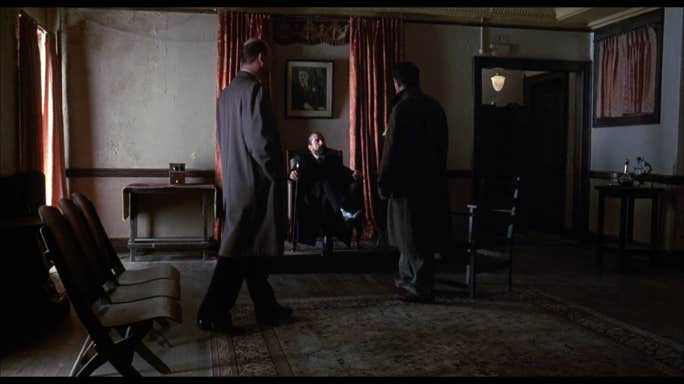
The first meeting between obviously satanic Lou Cyphre (Robert DeNiro) and Harold Angel (Mickey Rourke) while attorney Winesap (Dann Florek) looks on. When you agree to work for the devil and things go badly, really, who’s to blame?
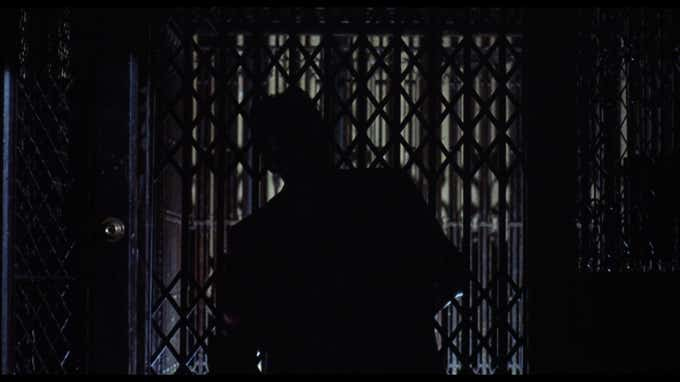
Supernatural ideas are represented by mid-20th-century design, so one descends to Hell in an industrial elevator.
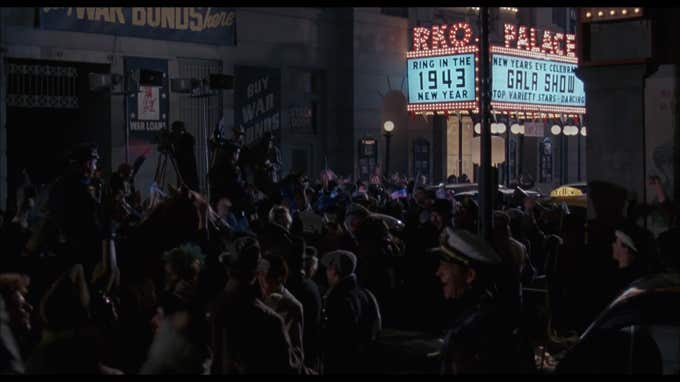
This scene takes place in the year 1942, on December 31st, 1942, the day on which we celebrate the upcoming year, 1943. If you think that this scene is happening on December 31st, 1943, you will be even more lost than the godforsaken protagonist.
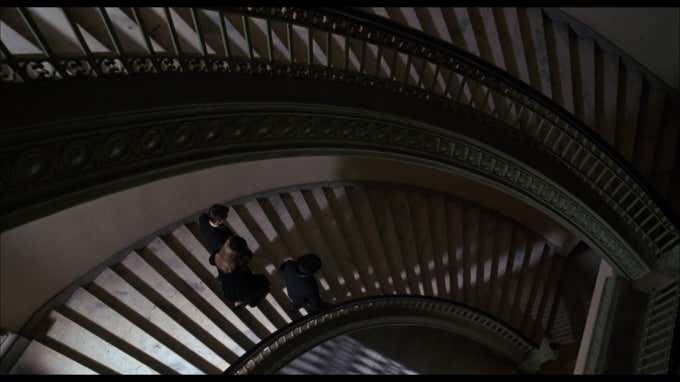
Johnny Favorite (now carrying the soul of Harold Angel), Margaret Krusemark and Toots Sweet leave the hotel after performing a human sacrifice. The spiral staircase adds to the eeriness of the scene.
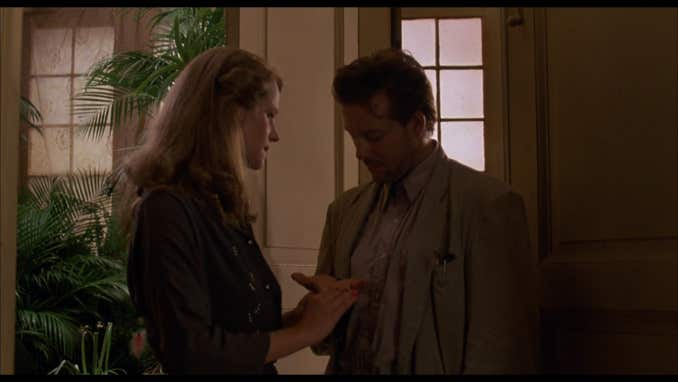
Margaret Krusemark reads Harry’s palm and possibly discovers that it is in the body of Johnny Favorite.
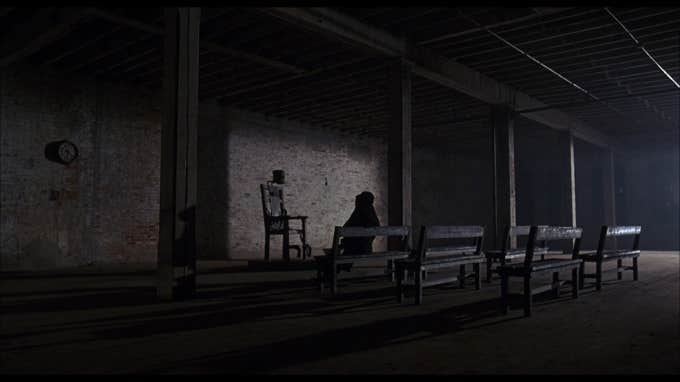
The “Woman In Black” in a non-descript building, observing an electric chair. Harry is eventually executed in an electric chair, so this is the only precognitive vision that Harry has.
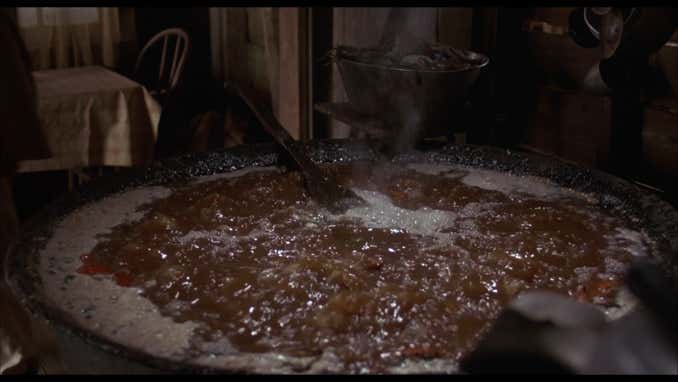
Angel Heart often gets creepy, pre-modern images into its 20th-century setting, and the gumbo pot looks like a witch’s cauldron. I don’t know if they make gumbo in 100-gallon batches at a time, but this seems real.
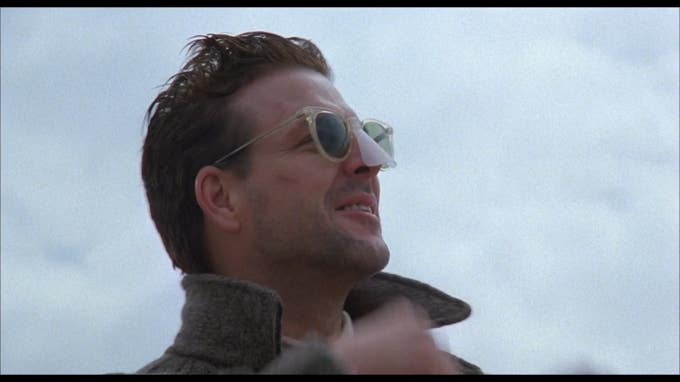
That Harry wears a nose protector is a little strange. That he procures one from a circus freak who found them under a rat-infested boardwalk is very strange.
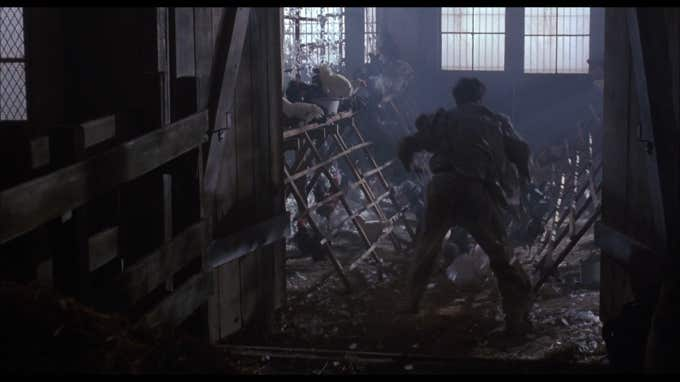
If a character is established to be afraid of chickens in the first act, he is going to be trapped in a chicken coop in the third act. Chekhov’s chicken?
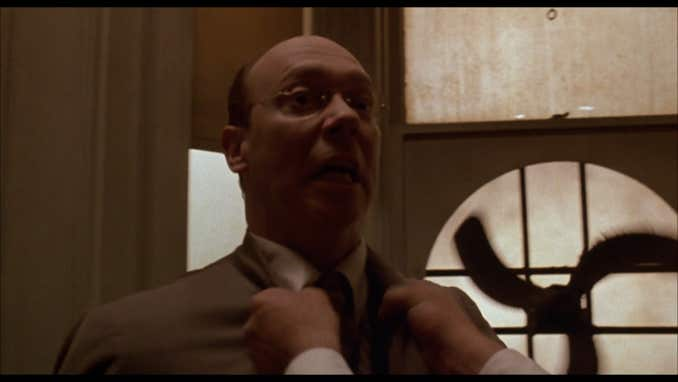
Winesap has the nerve to act surprised when his deal with the devil goes south.
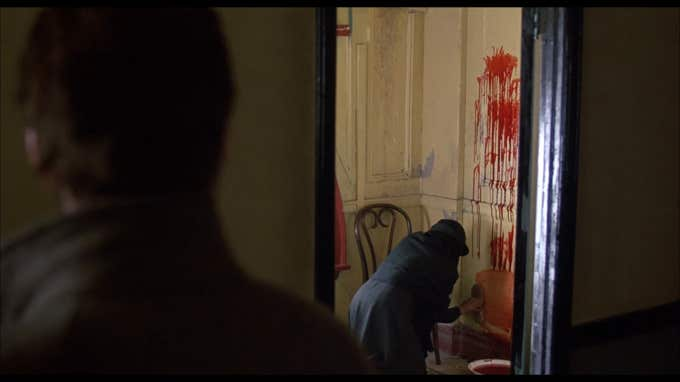
Harry meets with Cyphre right after a “suicide” in the neighboring office. The woman cleaning up the mess is more than she seems.
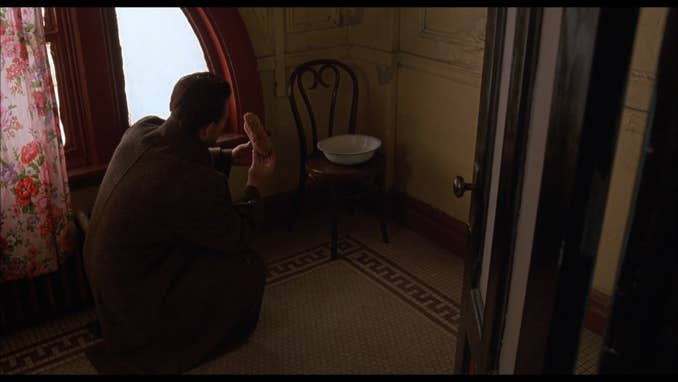
The blood stain is completely gone the next day. It’s such an amazing job that I assume it is meant to be symbolic of “removing blood” as disguising of guilt.
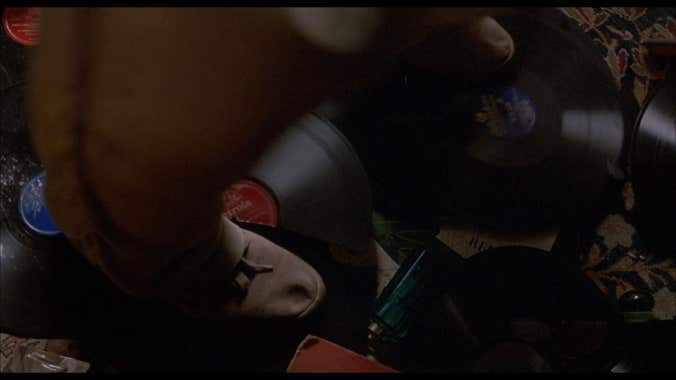
A copy of Johnny’s hit single is crushed, almost as if the last “record” of his existence is gone now that sinister forces no longer need him to exist in any form.
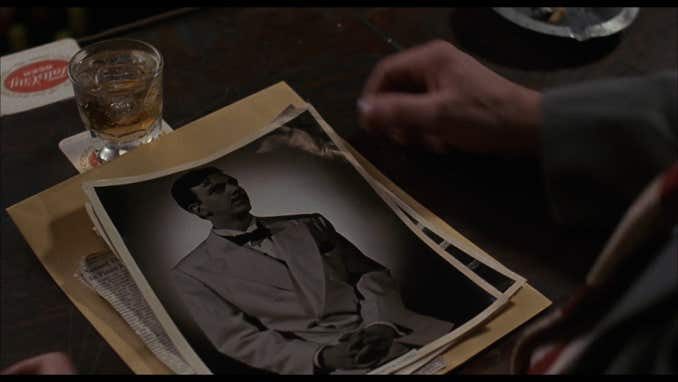
This is the only time in the movie we actually see Johnny Favorite, and this is the only picture of him in existence, even though he’s supposed to be a celebrity.
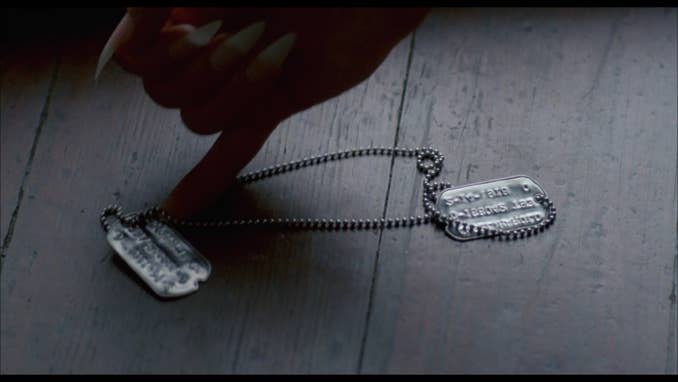
The last time we see Louis Cyphre, he is taking the dog tags of Harold Angel and the gun registered to Harold Angel, both of which appear at the murder of Epiphany Proudfoot. If Cyphre framed Harry, it’s not a stretch to assume that Cyphre was party to the murder.
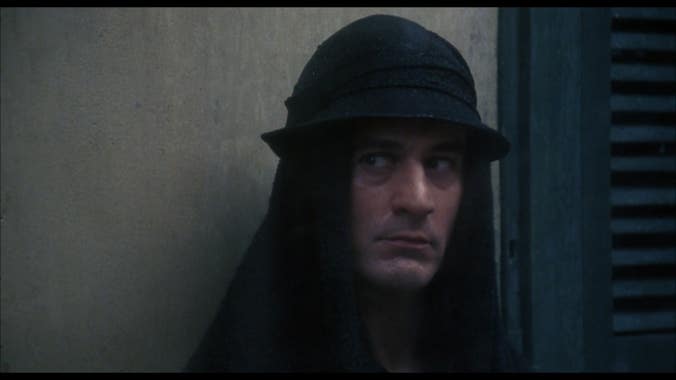
The identity of the Woman in Black is revealed — a revelation that raises more questions than it answers.
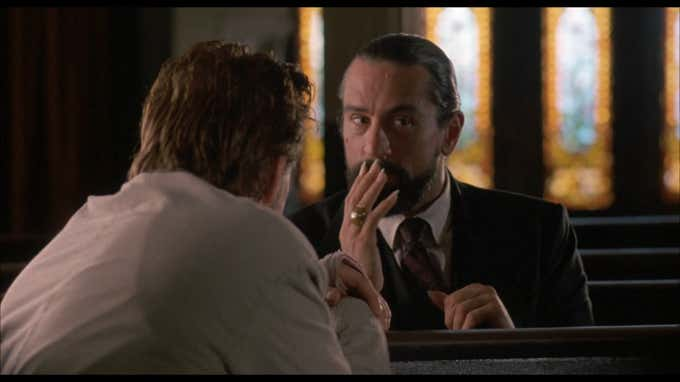
While discussing the disturbing aspects of the case, Harry uses profanity and Cyphre scolds him for swearing in a church.


